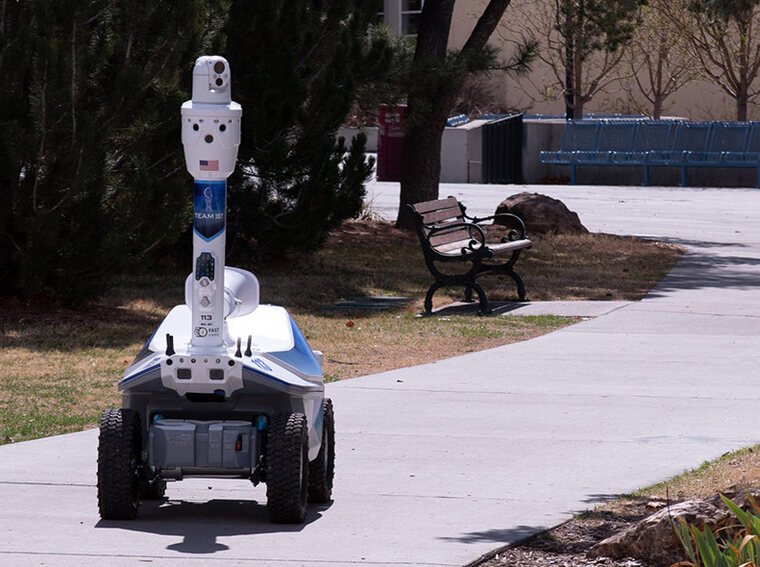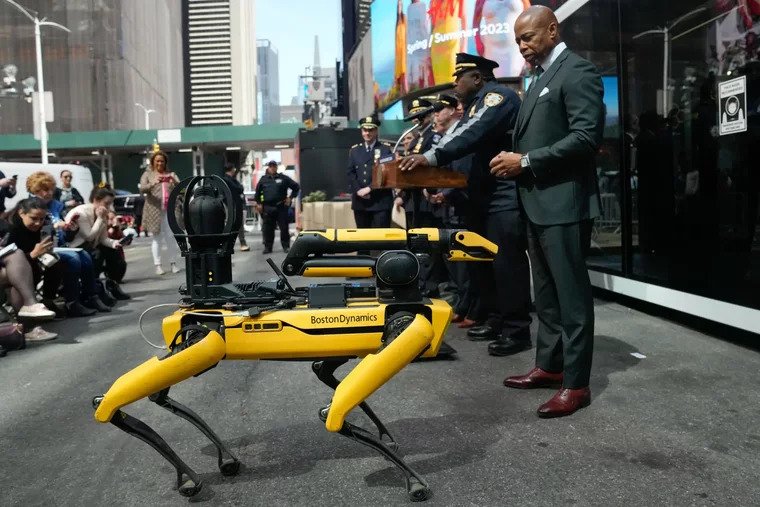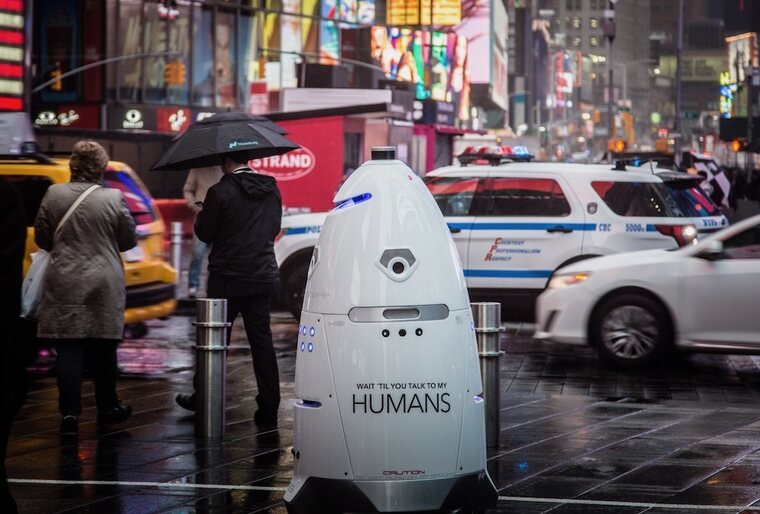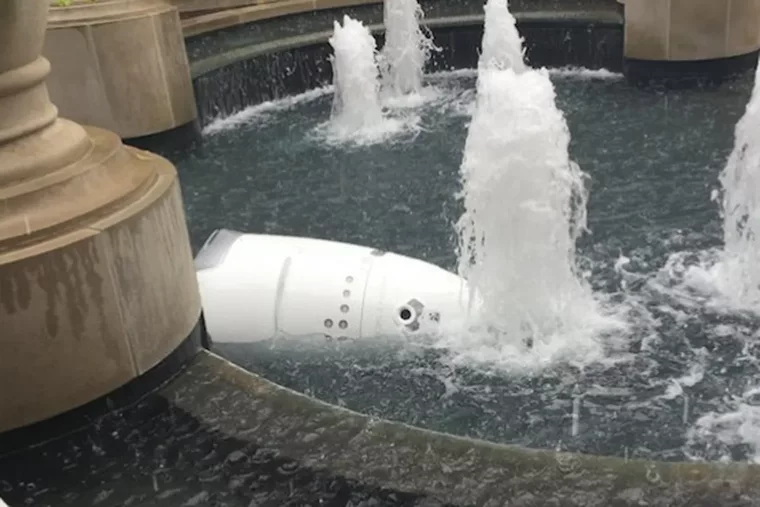The demand for enhanced security measures has prompted an increasing number of sectors to turn to autonomous security robots to bolster public safety.
From schools to police departments in major cities, these novel security robots equipped with artificial intelligence (AI) are being deployed to monitor and identify potential threats, turning what would have been once considered the stuff of science fiction into a reality.
One of the pioneers in this field is Santa Fe High School in New Mexico, which is currently piloting an autonomous robot developed by Albuquerque-based Team 1st Technologies, according to a recent report by the Wall Street Journal.
This 5-foot, 400-pound wheeled robot equipped with seven mast-mounted cameras is designed to tirelessly patrol the school premises, providing the human security officers with a comprehensive and continuous 360-degree live video feed.


Through the utilization of AI technology, the security robot learns and familiarizes itself with the school’s unique characteristics, including its layout and activity patterns.
The droid, resembling a miniature robotic brontosaurus, reportedly can identify aggressive or suspicious behavior, enabling it to approach and notify intruders of their observation. Human security officers can also remotely interact with potential unwanted guests via the robot’s communication system.
In the event of an active shooter or significant physical threat, the security robot promptly alerts the security team while moving toward the threat, transmitting real-time video footage to assist law enforcement officers in determining an appropriate course of action.
Team 1st Technologies has waived charges for the trial period. However, the standard rate for the AI-powered security robot is estimated to be approximately $65,000 for an entire school year.
Schools aren’t the only ones embracing the use of autonomous security robots. In April, the New York City Police Department (NYPD) announced it would test multiple robots for law enforcement purposes.
“If we were not willing to move forward and use technology to properly keep cities safe, then we will not keep up with those who are doing harmful things to hurt New York,” Mayor Adams said at a press conference unveiling the robots.
According to New York City Mayor Eric Adams, the NYPD will use $750,000 from asset forfeiture funds to acquire two “Digidogs” developed by Massachusetts-based Boston Dynamics.
These versatile quadruped robots, known as Spot, operate autonomously or semi-autonomously and can be deployed in hazardous situations where human officers may face risks.
Equipped with cameras, the Digidogs can approach and livestream images from potential bomb threat sites, aiding in formulating effective action plans.


Additionally, beginning this summer, the NYPD has deployed the K5 Autonomous Security Robot, constructed by California-based Knightscope, in the Times Square subway station.
Resembling a cross between R2-D2 and a rocket, the nearly 400-pound, 5-foot-tall K5 robot features a 360-degree camera and multiple microphones to monitor its surroundings for suspicious activities.
According to Knightscope, the K5 security robot can perform thermal anomaly detection, automatic signal detection, and license plate recognition. It’s yet to be determined if the security robot currently being tested by the NYPD possesses these features.
Though the NYPD will only be testing one K5 robot, on its website, Knightscope says multiple security robots can be monitored by a single human operator using the company’s Security Operations Center technology.


While autonomous security robots have the potential to significantly impact public safety, not everyone is excited about these AI droids being deployed on the public.
Communities United for Police Reform voiced concerns following the NYPD’s announcement, saying, “We need to invest in housing, education, mental health care, and community programs that will keep us safe, not investment in new and expensive technologies to criminalize us further.”
The New York-based privacy and civil rights group, The Surveillance Technology Oversight Project (STOP), has similarly condemned the NYPD’s use of autonomous security robots, calling the technology a “knockoff Robocop.”
“The NYPD is turning bad science fiction into terrible policing,” said STOP Executive Director Albert Fox Cahn. “New York deserves real safety, not a knockoff robocop. Wasting public dollars to invade New Yorkers’ privacy is a dangerous police stunt.”
In 2020, the NYPD attempted to test Boston Dynamics’ “Digidog” as a high-tech crime-fighting sidekick. However, a year later, the program was canceled following public outcry. During its brief stint on the force, critics called the robot “creepy” and likened it to a dystopian surveillance drone.
Following the early termination of a $94,000 lease with Boston Dynamics, John Miller, the NYPD’s Deputy Commissioner for intelligence and counterterrorism, said the robotic dog had been improperly used to fuel arguments about race and police surveillance.
“People had figured out the catchphrases and the language to somehow make this evil,” Miller told the New York Times.
It’s unclear what prompted the NYPD to relaunch efforts to integrate autonomous security robots into the police force two years after the program’s cancellation. One potential reason could be that the public is slowly becoming more accepting of integrating AI and robotics into everyday life.
A 2022 survey by the Pew Research Center found that 18% of Americans were more excited than concerned about artificial intelligence, while 45% were equally concerned and excited. Of those polled, 37% said they were more concerned than excited.
63% of Americans being excited or ambivalent about AI doesn’t suggest people will rush out to buy their own autonomous robot. However, the figure does show a gradual increase in acceptance from the 53% of Americans who viewed AI as “mostly a good thing for society” based on the Pew International Science Survey taken over 2019-2020.
A 2021 study by the U.S. Air Force Research Laboratory found that people were generally more trusting and accepting of autonomous security robots when used for military applications, patrolling high-crime neighborhoods, or protecting government buildings. Conversely, study respondents were less trusting of security droids if being used in their homes, low-crime neighborhoods, or as crowd control for public events.
One of the primary concerns repeatedly cited in studies on social acceptance of autonomous security robots relates to privacy concerns and the use of the devices for surveillance of the general public.
New York City officials have said that none of the NYPD’s new security robots will use facial recognition technology or carry any weaponry.
Likewise, the autonomous security robot being tested at Santa Fe High School will not use facial recognition capabilities, and school officials will be responsible for managing the captured footage, including determining its storage duration.
As of now, the Team 1st Technologies security robot is also unarmed, and the school has chosen to deactivate its weapon detection capabilities. However, Mario Salbidrez, the executive director of safety and security at Santa Fe Public School, expressed that the school administration is contemplating activating the robot’s weapons feature later, highlighting the ongoing evaluation and consideration of advanced security measures.
Aside from public acceptance, a critical aspect in deciding the fate of autonomous security robots will come down to the state of technology and the ability to perform jobs that would otherwise be reserved for a human.
In 2016, a Knightscope K5 security robot made headlines after it knocked down a 16-month-old toddler and coldly rolled away while patrolling the Stanford Shopping Center in Silicon Valley.
The following year, another K5 security droid -lovingly nicknamed Steve- was back in the news after it drowned itself by rolling into a water fountain at an office complex it was supposed to be patrolling in Washington, D.C.


That said, as the demand for enhanced security measures continues to rise, the deployment of autonomous security robots offers a promising solution.
By leveraging AI and emerging technologies, these droids can monitor and respond to potential threats more efficiently and accurately than their human counterparts.
Should pilot programs like those underway at Santa Fe High School or the NYPD prove successful, other institutions may soon adopt these machines, bolstering safety measures across the nation.
And while balancing the benefits of advanced technology with societal concerns will likely remain an ongoing challenge, the successful integration of autonomous security robots in schools and cities has the potential to pave the way for a safer future.
Tim McMillan is a retired law enforcement executive, investigative reporter and co-founder of The Debrief. His writing typically focuses on defense, national security, the Intelligence Community and topics related to psychology. You can follow Tim on Twitter: @LtTimMcMillan. Tim can be reached by email: tim@thedebrief.org or through encrypted email: LtTimMcMillan@protonmail.com
